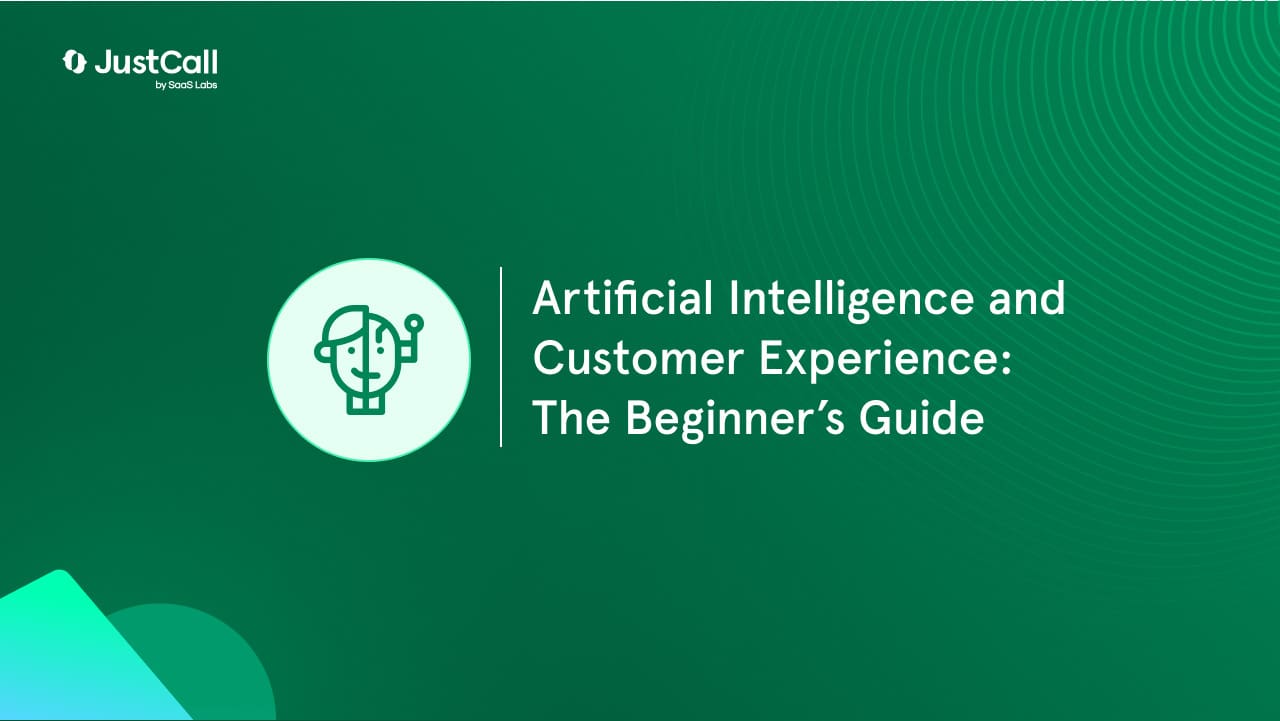Using Artificial Intelligence (AI) to improve your customer experience is a benchmark most businesses want to achieve, and probably even surpass today. The North Star for customer-first organizations is building a symbiotic relationship between AI and CX balancing human capabilities and technical skills.
This is propelling the global artificial intelligence market towards growth with data expecting it to reach $1,811.8 billion by 2030. In this guide, we will cover everything you need to know about how AI can improve customer experience. Let’s get to it.
What Is AI Customer Experience?
The role of artificial intelligence in customer experience cannot be denied or ignored. AI Customer Experience (AI CX) uses artificial intelligence (AI) technologies (think: machine learning, natural language processing, etc.) to optimize interactions between brands and customers.
AI customer experience can manifest in different forms across touchpoints:
- You can use chatbots and virtual assistants to provide real-time assistance.
- AI-powered recommendation systems can offer exacting suggestions on what you may want to buy or view.
- Sentiment analysis can enable organizations to gauge customer emotions.
- Intelligent analytics helps preempt customer needs.
The list goes on.
By implementing AI in customer experience strategies, customers can expect efficient and responsive service. They can get their queries resolved on the fly. They can enjoy hyper-personalized recommendations to cement a stronger relationship with the brand.
On the business side of things, AI is known to boost worker productivity by 14% besides providing other benefits (more on this later).
All in all, as technology continues to advance, AI CX is all set to play a pivotal role and businesses stay ahead of the curve—and their customer’s expectations.
Understand Your Customers Like Never Before With JustCall AI
How AI Can Improve Customer Experience: 5 Interesting Strategies
Instead of talking the talk, let’s walk the walk and show you exactly how AI is already improving customer experiences for brands across the board:
1. Personalization is AI’s biggest gift to brands
Thanks to brands such as Netflix, YouTube, Amazon, and others in the same league, customers experience personalization day in and day out. In fact, customers today are so accustomed to AI’s recommendations that they actually miss it if the shopping experience is traditional.
For instance, imagine if you log into your Netflix account and don’t get to see the “Top picks for you” or any “Because you watched [x]…” recommendations, the browsing experience would definitely feel incomplete to you.
This is the magic of AI algorithms at play. According to Netflix’s own admission, the brand aims to deliver an end-to-end “personalized homepage experience: one that offers movies and TV shows that are relevant to each member’s full palate of tastes, can fit the member’s current mood and context.”
2. Instant support for customers
AI-powered virtual assistants offer round-the-clock and instant customer support. Take for instance H&M’s use case that uses chatbots on its website and app to help customers find every possible answer to their order, payment, refund, and more.
3. Sentiment analysis is an AI specialty
Gauging customer emotions is somewhat of a superpower that brands can leverage, thanks to AI. For instance, organizations can deploy chatbots on their website to collect customer feedback and monitor interactions as Lululemon’s live chat demonstrates below.
Think of live chat as a powerful tool that helps your business to:
- Identify the customer’s pain points
- Tailor strategies to address their specific concerns
- Improve customer service continuously
4. AI-driven predictive analytics to forecast customer behavior
Imagine if a company could predict when you would like to purchase a certain item and offer proactive suggestions in advance, wouldn’t that be great?
Amazon does this with great tenacity and accuracy.
One, the brand allows you to literally pick up shopping from where you left off – a contextual experience at its best.
Two, it offers highly-suitable incentives and deals to boost sales.
Three, it makes use of customer data to drive targeted marketing campaigns.
5. Voice and image recognition
AI can process voice commands and visual searches to enhance the user experience. A great real-life example of this functionality would be Google Lens, which allows you to take pictures of products you wish to buy.
The AI then analyzes these images to bring up relevant data and shoppable URLs so you can enjoy a seamless shopping experience.
4 Best Practices for Using AI in Customer Experience
1. Identify the biggest issues your customer service agents face and use AI to iron out those issues: According to HubSpot, here are the biggest challenges customer service agents face.
Pro tip: In addition to understanding the pain points of your agents, learn about what your service leaders need as well.
2. Think about leveraging the services of a human agent and chatbot to deliver a superior customer experience: If your organization deals with basic, FAQ-type questions, chatbots are sufficient.
However, if you want to deal with more complex and sensitive customer cases, you need to allow a live agent to step into the conversation. In technical terms, this is known as augmented messaging which is a tool that gives you the best of both worlds (human personalization and AI scalability).
3. Use AI to prioritize requests the right way: If you think AI cannot assess your customer’s emotions, you’re in for a surprise. Owing to the use of natural language processing technology, AI can:
- Interpret customer responses accurately.
- Guide agents to react to their queries without escalating the situation.
- Identify certain keywords to analyze the nature of the customer’s problem.
- Learn more about the customer’s urgency as well as their full spectrum of emotions to tag the right agent who can take over the issue at hand.
4. Allow your customers to engage in self-service: As time-consuming as it may be to set up, a dedicated knowledge base can save your agents a lot of valuable time. You can leverage AI writing tools such as Chat.GPT or Jasper AI to do the writing for you.
These tools can help kickstart your content marketing efforts and give you a solid foundation to experiment with. You can always change the words, tone, and style to align with your brand’s suitabilities.
Pro tip: AI tools can also be used to curate customized emails and respond to each and every customer without losing out on that coveted personalized flavor.
For instance, Charles and Keith trigger an automated email asking the customer for their feedback so that it can capture the customer’s voice and understand what’s working for the brand (and more importantly, what’s not).
The Final Word: Is Customer Experience and AI a Match Made in Heaven?
By 2030, artificial intelligence (AI) is expected to grow twentyfold up to nearly two trillion U.S. dollars.
Clearly, businesses that put AI strategies on the back burner will bear the brunt of lost customers, poor innovation, and slow service.
So, instead of treating AI as an afterthought, the real question to ask is: How does AI improve customer experience?
For starters, AI can augment the skills of human assets to give organizations a clear, decided advantage. That said, it is crucial for enterprises to strike a balance between AI-driven automation and the human touch as genuine emotional connections remain the cornerstone for fostering long-term customer loyalty.
By embracing AI as a strategic enabler rather than a replacement for human interaction, businesses can deliver memorable and empathetic customer journeys. Moreover, it can lay the foundation for continuous learning, boost scalability, and drive cost-effectiveness to ensure a competitive edge in meeting customer demands (and expectations).
Given that only 10% of organizations obtain significant financial benefits from AI technology, the need of the hour is to:
- Stay informed about the latest AI advancements
- Invest in robust AI infrastructure
- Drive organizational learning with AI, broadly and deeply
- Prioritize AI-powered customer-centricity throughout the operations
By doing so, businesses can better position themselves at the forefront of the dynamic customer landscape. With the right vision and approach, AI in CX can radically alter the way customers feel about your brand and reshape the future of customer experience.












